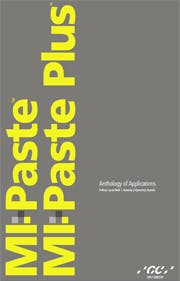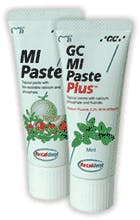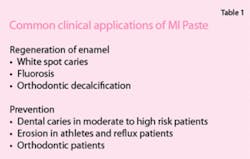Which ones to use where
by Laurence J. Walsh, DDSc, PhD
With expansion in the range of products containing CPP–ACP technology (Recaldent™), the following question inevitably arises: Which product do you use, and where? Casein phosphopeptides (CPP) have been shown to stabilize amorphous calcium phosphate (ACP). There is extensive literature demonstrating that Recaldent (CPP–ACP) has anti–caries and remineralizing effects. Interestingly, CPP has also been shown to stabilize amorphous calcium fluoride phosphate (CPP–ACP), which has an additive effect compared with the separate remineralization effects of fluoride or CPP–ACP. This latter point underpins the recently released product MI Paste Plus.
Recaldent chewing gum
Recaldent chewing gum derives benefit from the delivery of bio–available calcium and phosphate, together with the improved salivary parameters which occur from stimulation of salivary flow. Additionally, the polyol components (xylitol and sorbitol) contained in the gum are nonfermentable substrates with passive anti–caries effects. Several clinical trials at the University of Melbourne have demonstrated the effects of Recaldent gum on remineralization of white spot lesions in vivo, and these studies confirm the superiority of Recaldent gum over conventional sugar–free gums which do not provide bioavailable calcium and phosphate. These clinical trials have demonstrated that CPP–ACP delivered in a sugar–free chewing gum can remineralize enamel subsurface lesions in vivo.1,2 In a randomized, cross–over, double–blind study, 30 subjects chewed gums with varying levels of CPP–ACP four times per day for 14 days.
The addition of CPP–ACP to either sorbitol– or xylitol–based gum resulted in a dose–related increase in enamel remineralization, with 54.4 mg of CPP–ACP (Recaldent) producing an increase in enamel remineralization of 152% relative to a control sugar–free gum.1 A recently completed large scale community–based randomized controlled trial investigated the radiographic progression and regression of dental caries in 2,720 adolescent patients who chewed a gum containing CPP–ACP over a two–year period.2
The test group received a sugar–free gum containing 54.4 mg CPP–ACP (Recaldent) while the control group received an identical gum without CPP–ACP. Patients chewed the gum for 10 minutes three times each day. Despite the fact that all patients received fluoridated water, a fluoride toothpaste, and access to professional care, analysis of standardized digital radiographs (Dexis) demonstrated that the CPP–ACP gum provided an additional significant benefit in caries management, slowing the progression of carious lesions compared with the control gum, and enhancing regression of carious lesions.
Figure 2. While MI Paste can be used in patients of any age, MI Paste Plus is particularly useful for patients with special needs who are older children or adults, where it is commonly used in protocols which include Dry Mouth Gel.
Based on these results, the inclusion of Recaldent gum can be a valuable addition to the personal oral care regimen of adolescent patients. Recaldent gum is ideally suited to both children and adult patients where a lifestyle activity is linked to subclinical dehydration, and the patient suffers from the problems associated with depressed salivary pH and flow under resting conditions. The introduction of Recaldent gum should be considered for patients who undertake strenuous activity, for example, through outdoor exercise, outdoor work, or gym training sessions.
The timing of gum chewing is important since the stimulation of salivary flow achieved by the gum will occur at a time when otherwise resting flow and pH would be depressed. Recaldent gum provides an excellent preventive effect, and is easily incorporated into a busy modern lifestyle.
MI Paste
MI Paste has had a major impact on the practice of preventive dentistry in Australia, and is now being introduced on the global dental market, with the name MI Paste being used in the North American market, and is known in Australia and New Zealand as Tooth Mousse. MI Paste has a broad range of applications as a part of home care (see Table 1). These are summarized in the March 2007 publication “MI Paste: Anthology of Applications” (see Figure l). In most preventive protocols, it is applied daily in a pea–size amount, using a finger, to the labial surfaces of the teeth immediately before bed. By dissolving slowly, the material contributes bioavailable calcium and phosphates to the saliva, and is able to promote remineralization at a time when salivary defenses are at their lowest point. MI Paste can be used in patients of all ages as the material is classified as safe to ingest.
An in–office application of MI Paste can be useful as a desensitizing treatment immediately following scaling and root planing, if root surface sensitivity is a concern for the patient. Repeated home use can prevent dental erosion and demineralization. For patients with arrested white spot lesions, dental fluorosis, or hypomineralization, pretreatment of the enamel is necessary before home use of MI Paste in order to ensure maximal penetration of ions into the enamel subsurface. This surface pre–treatment normally involves etching with orthophosphoric acid for thirty seconds as an in–office procedure prior to subsequent use of MI Paste at home, or in the case of dental fluorosis, a two–minute etching cycle. Typically, gentle surface abrasion with pumice is combined with the etching procedure. Detailed clinical protocols have been presented in the MI Paste portfolio series of publications, and in the anthology of MI Paste applications.3
MI Paste Plus
This is a recent addition to the range of Recaldent products, and differs in that the product delivers, in addition to bioavailable calcium and phosphate, 900 parts per million fluoride, a level similar to conventional adult–strength toothpaste. MI Paste Plus was designed to have enhanced mineralizing capabilities compared with CPP–ACP, providing the ideal calcium phosphate fluoride ratio for maximum remineralization. Detailed studies have shown that treatment of white spot lesions with CPP–ACFP causes these to become more translucent, with fluoride being found evenly throughout the body of the remineralized lesions by deposition of fluorapatite.4
Direct comparisons of MI Paste Plus and conventional MI Paste show the superior remineralizing capabilities of MI Paste Plus; however, ingestion is an issue for children with a low body weight where ingestion of any fluoride source needs to be considered very carefully.
As the fluoride level in MI Paste Plus is similar to that of adult–strength toothpaste, use of MI Paste Plus as a home care self–administered measure is contraindicated in children less than six years of age. Indeed, the product is designed to suit the needs of patients in high–risk situations where salivary production is greatly diminished, for example, in patients with SjÖgren's syndrome, patients who have had irradiation of the head and neck, patients with profound salivary dysfunction caused by medications, etc.
The at–home application of MI Paste Plus is suitable for special–needs patients; it can also be used for in–office treatments, particularly for densensitization. The at–home applications of MI Paste Plus align strongly with another recent GC America product, Dry Mouth gel, which provides relief from symptoms of oral dryness while maintaining oral pH in a safe range to prevent demineralization (Figure 2). This would normally be used for symptomatic relief during the day and before bed, with the additional use of sodium bicarbonate mouthrinses after meals to maintain the oral pH in the neutral to alkaline range.
References
- Shen P, Cai F, Nowicki A, Vincent J, Reynolds EC. Remineralization of enamel subsurface lesions by sugar–free chewing gum containing casein phosphopeptideamorphous calcium phosphate. J Dent Res. 2001 Dec;80(12):2066–70.
- Morgan MV, Adams GG, Bailey DL, Tsao CE, Reynolds EC. CPP–ACP gum slows progression and enhances regression of dental caries. J Dent Res 2006; 85 (Sp. Iss. B): 2445.
- Walsh LJ. Tooth Mousse: Anthology of Applications. GC Asia Dental, 2007.
- Cochrane NJ, Cai F, Reynolds EC. QLF and TMR analysis of CPP–ACFP remineralized enamel in vitro. J Dent Res 2006; 85 (Sp. Iss. B): 0192.










